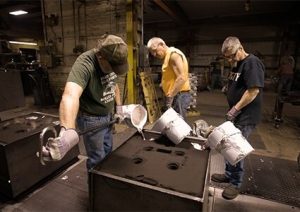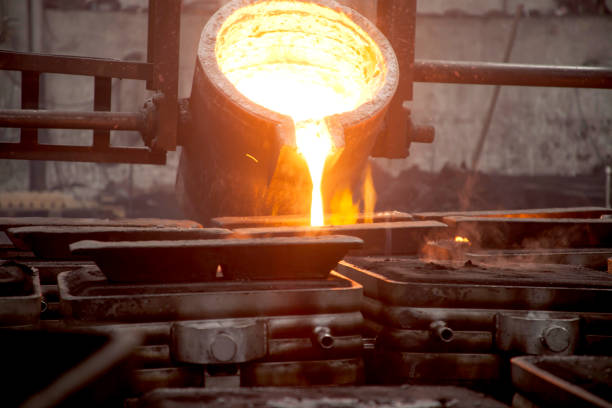The Science Behind Aluminum Castings and Their Superior Performance
Wiki Article
Exploring the Ingenious Strategies Made Use Of in Modern Aluminum Foundries
Modern aluminum foundries are undergoing a substantial change via the fostering of innovative strategies. Advanced casting methods, wise automation, and lasting practices are reshaping manufacturing processes. These improvements not just improve effectiveness yet also address environmental worries. As the sector evolves, the combination of electronic modern technologies plays a necessary duty. Understanding these modifications is crucial for understanding the future of aluminum manufacturing and its ramifications for international markets. What exists ahead in this dynamic industry?Advanced Casting Techniques

Additionally, developments in thermal control and mold and mildew layout have actually added to even more regular casting results. These developments permit much better control of cooling down prices, lowering issues and improving mechanical residential properties. Because of this, manufacturers can develop light-weight yet long lasting elements, meeting the increasing needs of different industries, including vehicle and aerospace, for high-performance aluminum components.
Smart Automation and Robotics
The integration of smart automation and robotics in aluminum foundries notes a considerable development in manufacturing performance. These technologies make it possible for precision and uniformity in production procedures, dramatically decreasing human mistake and improving safety and security. Automated robotic systems take care of repeated jobs, such as molding, pouring, and air conditioning, enabling human drivers to concentrate on more complicated responsibilities that call for vital thinking and oversight.In addition, clever sensors and AI-driven analytics supply real-time data surveillance, helping with predictive upkeep and lessening downtime. This leads to maximized resource appropriation and boosted power usage, adding to total sustainability in manufacturing.
Moreover, the flexibility of robot systems permits for quick changes to altering manufacturing demands, boosting versatility in manufacturing. As foundries significantly take on these advanced innovations, they not only enhance functional performance but also position themselves as leaders in technology within the steel casting industry.
Additive Manufacturing in Foundries
Changing typical manufacturing approaches, additive manufacturing is transforming aluminum foundries by allowing the production of complex geometries that were previously unattainable. This technique enables for the layer-by-layer building and construction of components, significantly reducing material waste and shortening manufacturing times. Because of this, foundries can generate complex styles that improve efficiency and capability, providing to the expanding needs of numerous sectors.In addition, additive production helps with fast prototyping, permitting engineers to test and iterate designs quickly. This dexterity not only accelerates the development cycle yet additionally assists in determining prospective issues prior to full-blown production begins. The integration of innovative materials and processes in additive production additionally improves the mechanical homes of aluminum parts, advertising advancement in product design. Subsequently, aluminum foundries that embrace these techniques place themselves at the leading edge of industry innovations, making certain competition in an ever-evolving market landscape.
Sustainable Practices and Recycling
Lasting practices in aluminum foundries are significantly concentrated on boosting recycling procedures and adopting green casting methods. These technologies aim to minimize waste and power usage while making the most of the usage of recycled products. As the industry advances, the integration of sustainability into manufacturing methods ends up being essential for satisfying ecological criteria and consumer demands.Reusing Process Improvements
As industries increasingly acknowledge the ecological influence of waste, aluminum foundries are embracing ingenious reusing process enhancements to improve sustainability. These innovations focus on lowering power consumption and making best use of material recovery. Many foundries are carrying out closed-loop systems that reuse scrap aluminum produced throughout manufacturing, minimizing waste and reducing the need for virgin materials. Advanced sorting technologies, such as computerized optical sorting, enhance the separation of different aluminum grades, raising the efficiency of the recycling procedure. Furthermore, some foundries are making use of hydrometallurgical approaches to recover aluminum from complex waste streams. By incorporating these improvements, aluminum foundries not just add to a round economy but also minimize their carbon impact, lining up with global sustainability goals.Eco-Friendly Casting Techniques
While traditional casting methods usually include substantial power consumption and product waste, aluminum foundries are significantly embracing eco-friendly casting strategies that focus on sustainability. Techniques such as low-pressure die casting, which lessens air exhausts, and making use of water-based mold releases contribute to minimized ecological effect. Additionally, innovations in 3D printing innovation enable the production of complex mold and mildews with less product waste. Numerous foundries are also carrying out closed-loop systems that reuse water and aluminum scrap, further lowering resource usage. By accepting renewable power resources, such as solar and wind power, these facilities improve their sustainability efforts. Overall, the fostering of environment-friendly techniques in aluminum casting not just profits the setting however likewise advertises economic effectiveness and technology within the market.Enhanced Quality Assurance Procedures
Boosted quality assurance measures in aluminum foundries are increasingly reliant on advanced assessment innovations and real-time tracking systems. These advancements make it possible for producers to detect issues early and guarantee consistent item quality. By incorporating these tools, foundries can markedly boost their operational performance and minimize waste.Advanced Evaluation Technologies
Advanced examination modern technologies play a vital duty in guaranteeing the top quality and dependability of aluminum spreadings. These advanced methods consist of non-destructive testing (NDT) techniques such as ultrasonic testing, radiographic testing, and eddy current examinations. Each technique permits thorough assessment of castings without endangering their structural integrity. Advanced imaging methods, such as computed tomography, provide a substantial view of interior functions, allowing the detection of issues like incorporations and voids. Furthermore, automated optical evaluation systems enhance accuracy by employing high-resolution electronic cameras and equipment discovering algorithms to assess surface area quality. By applying these advanced evaluation technologies, aluminum foundries can properly minimize flaws, ensuring that spreadings fulfill stringent market standards and client requirements.Real-Time Monitoring Solutions
As manufacturers endeavor for excellence in aluminum casting, real-time monitoring systems become a critical enhancement in quality assurance actions. These systems utilize sophisticated sensing units and data analytics to constantly track vital you can try these out specifications throughout the casting procedure, such as pressure, temperature, you can check here and alloy structure. By supplying immediate responses, they make it possible for operators to identify variances from ideal conditions and make timely adjustments. This aggressive technique not only reduces defects but additionally enhances general efficiency and decreases waste - Aluminum Foundry. Additionally, assimilation of real-time information right into manufacturing monitoring systems assists in much better decision-making and improves traceability. Subsequently, real-time surveillance systems play an important duty in keeping high requirements of top quality in contemporary aluminum foundries, making certain that items fulfill rigorous sector specificationsDigital Twin Innovation for Optimization

The combination of electronic twin modern technology allows foundries to test different scenarios without disrupting actual manufacturing. This capacity fosters an aggressive approach to maintenance and resource monitoring, inevitably decreasing waste and reducing functional prices. In addition, the innovation help in procedure optimization by permitting designers to visualize the impacts of changes in real-time, making certain greater top quality results. As an outcome, aluminum foundries taking on digital twin technology are placed to accomplish greater efficiency and competitiveness in a progressively requiring market.

Sector 4.0 and IoT Integration
The adoption of electronic twin technology in aluminum foundries becomes part of a wider activity in the direction of Sector 4.0, identified by the assimilation of the Web of Things (IoT) into making procedures. This integration allows real-time tracking and information collection from numerous machinery and equipment, resulting in improved functional performance. Sensing units installed in makers collect crucial information, which is examined to optimize manufacturing process and anticipate maintenance demands.IoT devices facilitate communication in between different manufacturing phases, enabling for smooth sychronisation and lessening downtime. By leveraging cloud computing, foundries can store and evaluate huge amounts of information, allowing more educated decision-making. This innovation likewise supports remote management, where drivers can look after processes from anywhere, improving responsiveness to production challenges. On the whole, the fusion of Industry 4.0 and IoT within aluminum foundries is changing conventional practices, making them a lot more receptive and agile to market needs.
Often Asked Concerns
What Are the Key Advantages of Aluminum Over Other Metals?
Aluminum offers numerous benefits over other metals, including its light-weight nature, exceptional corrosion resistance, high thermal and electrical conductivity, malleability, and recyclability, making it a favored selection for various applications across numerous industries. - Metal CastingsJust How Do Modern Foundries Take Care Of Hazardous Materials?
Modern foundries take care of hazardous products through strict safety protocols, advanced filtering systems, and reusing techniques. Regular training assurances employees understand best methods, while keeping an eye on systems detect and mitigate potential threats to maintain a risk-free working atmosphere.What Is the Normal Life-span of Aluminum Castings?
The common lifespan of aluminum castings varies from 20 to 50 years, relying on factors such as ecological problems, use, and upkeep. Correct care can extend their toughness and efficiency significantly gradually.Exist Any Kind Of Health Dangers Related To Aluminum Foundry Job?
Yes, aluminum factory work postures health and wellness dangers, including respiratory problems from breathing in fumes and dust, skin inflammation from contact with molten steel, and potential exposure to unsafe chemicals. Correct safety and security procedures are important to minimize these risks.Exactly How Do Shops Ensure Worker Safety in High-Temperature Environments?
Foundries execute extensive security protocols, including protective gear, temperature level surveillance systems, and routine training. These steps guarantee that employees are outfitted to manage high-temperature atmospheres, reducing threats and advertising a much safer workplace.
Countless sophisticated casting methods have actually arised in aluminum foundries, reinventing conventional procedures. Lasting practices in aluminum foundries are significantly concentrated on enhancing reusing processes and taking on green casting methods. Many you could try here foundries are applying closed-loop systems that recycle scrap aluminum created during production, lessening waste and decreasing the demand for virgin materials. While typical casting techniques often include significant power consumption and material waste, aluminum foundries are increasingly embracing eco-friendly casting methods that focus on sustainability. While numerous sectors are increasingly embracing electronic technologies, aluminum foundries are leveraging electronic twin innovation to boost operational effectiveness and maximize production processes.
Report this wiki page